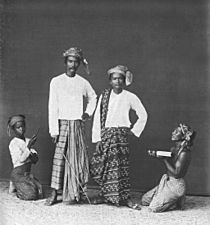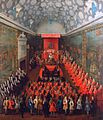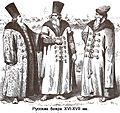Nobility facts for kids

Nobility refers to a special group of people who were often at the top of society a long time ago. In many old societies, especially in Europe, noble people were given land by the monarch (a king or queen). In return, they had to offer services, usually by fighting in the military. Men in this group were called noblemen, and women were called noblewomen. Over time, being noble became something you were born into, meaning it was passed down through families. Nobles often had special titles and certain advantages, like not having to pay some taxes.
Today, in most countries, being noble doesn't come with special legal advantages anymore. However, in the United Kingdom, some noble titles still exist. These titles, like those of the peerage, used to guarantee a seat in the House of Lords, which is part of the UK Parliament. While this has changed, some smaller privileges might still exist.
Contents
What is Nobility?
Nobility was a very important social class in many societies before modern times. These groups of people were usually seen as being above everyone else. They often owned a lot of land and had significant power.
Nobility in the Past
In the feudal system, which was common in Europe and other places, nobles played a key role. A king or queen would give land to a nobleman. This land was called a fief. In exchange for the land, the nobleman promised to be loyal and provide soldiers for the king's army.
Over time, this system changed. Being noble became something you inherited from your parents. This meant that if your parents were noble, you would be noble too. Nobles often had special titles, like Duke, Count, Baron, or Lord. They also had certain privileges, which were special rights or advantages. These could include owning large estates, having a say in government, or being exempt from certain laws.
Nobility Around the World
Nobility wasn't just found in Europe. Many different cultures had their own forms of noble classes. For example, in Japan, the Samurai were a noble warrior class. In India, there were groups like the Maratha nobles and the Nair caste. In Korea, the yangban were a noble class. These groups often had similar roles, like providing military service or helping to govern.
Roles of Nobles
Nobles often had many responsibilities. They managed their lands and the people living on them. They also served as advisors to kings and queens. In times of war, they led armies and fought battles. Their power came from their land, their wealth, and their family name.
Nobility Today
In most parts of the world today, nobility does not have the same power or legal advantages it once did. Many countries have gotten rid of special noble privileges. This means that everyone is equal under the law, no matter their family background.
However, some countries still have noble titles. In the United Kingdom, for example, titles like Duke, Earl, and Baron still exist. While these titles don't give special legal rights anymore, they are still part of the country's traditions. Some people with these titles are still involved in public life or charity work.
Images for kids
-
The House of Lords is the upper legislature of the Parliament of the United Kingdom and is filled with members that are selected from the nobility (both hereditary titleholders and those ennobled only for their individual lives).
-
A French political cartoon of the three orders of feudal society (1789). The rural third estate carries the clergy and the nobility.
-
Count Carl Robert Mannerheim (1835–1914), a Finnish aristocrat, businessman, and the father of Baron C. G. E. Mannerheim, the Marshal of Finland
-
Russian boyars
-
The Battle of Tewkesbury in 1471. Large numbers of English nobility perished in the Wars of the Roses
-
In Korea, royalty and yangban aristocrats were carried in litters called gama. A Korean gama, circa 1890.
-
An aristocratic family in Lhasa, Tibet in 1936.
-
Typical costume of a family belonging to the Principalía of the late 19th century Philippines. Exhibit in the Villa Escudero Museum, San Pablo, Laguna.
-
A pre-colonial Tagalog couple belonging to the Datu class or nobility as depicted in the Boxer Codex of the 16th century.
-
Emperor Haile Selassie I of Ethiopia (center) and members of the imperial court
-
King Radama I of Madagascar was from the Andriana stratum of the Merina people.
-
Portrait of Marquis of Paraná, Prime Minister of Brazil.
-
Regent of Bandung, Java, Dutch East Indies, with his pajung bearer – 1863–1865
-
A Siamese noble in a hammock, 1900
See also
 In Spanish: Nobleza para niños
In Spanish: Nobleza para niños




























